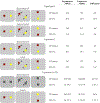Features, as well as space and time, guide object persistence
- PMID: 21037174
- PMCID: PMC6999814
- DOI: 10.3758/PBR.17.5.731
Features, as well as space and time, guide object persistence
Abstract
What role do surface features (e.g., color) play in the establishment and maintenance of episodic representations of objects (object files)? Mitroff and Alvarez (2007) showed that stimuli that were linked by a continuous spatiotemporal history yielded object-specific preview benefits--a standard index of object files-whereas stimuli linked only by shared surface features did not. Here, it is shown that abruptly changing the features of an object that has been established on the basis of spatiotemporal history can disrupt object-specific preview benefits (Experiments 1 and 2). Moreover, under some conditions, feature match alone can give rise to the preview benefits (Experiment 3). These results indicate that surface features, as well as spatiotemporal factors, play an important role in establishing and maintaining episodic object representations.
Figures

Similar articles
-
Surface feature congruency effects in the object-reviewing paradigm are dependent on task memory demands.Psychon Bull Rev. 2014 Aug;21(4):1019-25. doi: 10.3758/s13423-013-0571-4. Psychon Bull Rev. 2014. PMID: 24474601
-
Object substitution masking and the object updating hypothesis.Psychon Bull Rev. 2010 Oct;17(5):737-42. doi: 10.3758/PBR.17.5.737. Psychon Bull Rev. 2010. PMID: 21037175
-
Object correspondence across brief occlusion is established on the basis of both spatiotemporal and surface feature cues.Cognition. 2009 Nov;113(2):150-66. doi: 10.1016/j.cognition.2009.08.004. Epub 2009 Sep 2. Cognition. 2009. PMID: 19729155 Free PMC article.
-
Object-based attention: a tutorial review.Atten Percept Psychophys. 2012 Jul;74(5):784-802. doi: 10.3758/s13414-012-0322-z. Atten Percept Psychophys. 2012. PMID: 22673856 Review.
-
Contextual effects on motion perception and smooth pursuit eye movements.Brain Res. 2008 Aug 15;1225:76-85. doi: 10.1016/j.brainres.2008.04.061. Epub 2008 Apr 30. Brain Res. 2008. PMID: 18538748 Review.
Cited by
-
An object-mediated updating account of insensitivity to transsaccadic change.J Vis. 2012 Oct 23;12(11):18. doi: 10.1167/12.11.18. J Vis. 2012. PMID: 23092946 Free PMC article.
-
What was that object? On the role of identity information in the formation of object files and conscious object perception.Psychol Res. 2020 Oct;84(7):2018-2033. doi: 10.1007/s00426-019-01200-7. Epub 2019 May 25. Psychol Res. 2020. PMID: 31129739
-
The role of color in transsaccadic object correspondence.J Vis. 2023 Aug 1;23(8):5. doi: 10.1167/jov.23.8.5. J Vis. 2023. PMID: 37535373 Free PMC article.
-
Paradoxical perception of object identity in visual motion.Vision Res. 2017 Jul;136:1-14. doi: 10.1016/j.visres.2017.04.008. Epub 2017 May 12. Vision Res. 2017. PMID: 28456533 Free PMC article.
-
Feature-based guidance of attention during post-saccadic selection.Atten Percept Psychophys. 2019 Aug;81(6):1822-1835. doi: 10.3758/s13414-019-01719-2. Atten Percept Psychophys. 2019. PMID: 30980343 Free PMC article.
References
-
- Brainard DH (1997). The Psychophysics Toolbox. Spatial Vision, 10, 433–436. - PubMed
-
- Burt P, & Sperling G (1981). Time, distance, and feature trade-offs in visual apparent motion. Psychological Review, 88, 171–195. - PubMed
-
- Dawson MR (1991). The how and why of what went where in apparent motion: Modeling solutions to the motion correspondence problem. Psychological Review, 98, 569–603. - PubMed
-
- Flombaum JI, & Scholl BJ (2006). A temporal same-object advantage in the tunnel effect: Facilitated change detection for persisting objects. Journal of Experimental Psychology: Human Perception & Performance, 32, 840–853. - PubMed
-
- Flombaum JI, Scholl BJ, & Santos LR (2009). Spatiotemporal priority as a fundamental principle of object persistence In Hood B & Santos L (Eds.), The origins of object knowledge (pp. 135–164). Oxford: Oxford University Press.
Publication types
MeSH terms
Grants and funding
LinkOut - more resources
Full Text Sources
